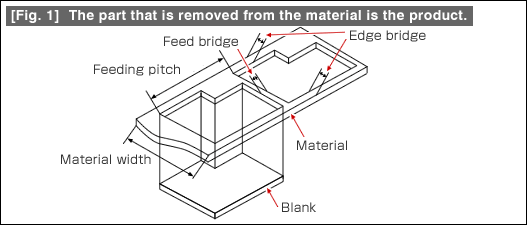#011 Basics of Blanking Work (1) Blanking Work
The basics of blanking work are blanking using a press. In blanking work, very often the contour shape of the press fabricated product is formed. The work of forming the contour shape is called external shape forming or blanking work. This is shown in Fig.

The material is made a little larger in order to prepare blanks. The part by which the material is made larger is called the "bridge". Bridges are of two types, namely, the "feed bridge" and "edge bridge". A guideline for the minimum value of the width of a bridge is as follows. - Feed bridge = 1.5t or 0.7mm, - Edge bridge = 1.5 x feed bridge.
In the case of shapes that are circular or with short straight line parts, it is also possible to make these a little smaller than the above. If the bridge width is made too small, it may not be possible to blank properly, or the wearing out of the punch and die becomes more rapid causing the generation of burrs. The feed pitch and the material width are obtained by adding the feed bridge and the edge bridge to the dimensions of the blank. The bridge widths are adjusted so that these two become integer numbers.
The relationship between the blank dimensions and the dimensions of the die is very important. Making a mistake in this can have very serious consequences. This relationship is shown in Fig. 2.
![[Fig. 2] Relationship between the die dimensions and product dimensions](http://www.misumi-techcentral.com/tt/en/press/images/012_2.gif)
In blanking work, the blank (product) dimensions are made the die dimensions. The punch will be made smaller by the amount of the clearance. The blank enters inside the die. The method of taking out the blank that is inside the die can be either taking it out by making it pass through the die or by taking it out from where it entered by pushing from inside the die. A part of the die that pushes the blank is called a knock out. Take care also about the direction in which burrs are generated during blanking work. (See Fig. 2.) Depending on the product, very often it is required to make the direction of burrs the same in the outer shape and the holes.
The arrangement of blanks during blanking work is called the blank layout (how blanks are taken from a plate). Some examples of this are shown in Fig. 3. The rate of utilization of the material differs depending on the arrangement. The arrangement is selected so that the material is not wasted.
![[Fig. 3] Blank layout](http://www.misumi-techcentral.com/tt/en/press/images/012_3.gif)
- #167 Problems in Punching and their Countermeasures (6) Scrap Processing in Punching
- #166 Problems in Punching and their Countermeasures (5) Trimming of Drawn and Shaped Parts
- #165 Problems in Punching and their Countermeasures (4) Scrap Clogging in Punching
- #164 Problems in Punching and their Countermeasures (3) Bending and Twisting of Narrow Punched Parts
- #163 Problems in Punching and their Countermeasures (2) Bending due to Punching



